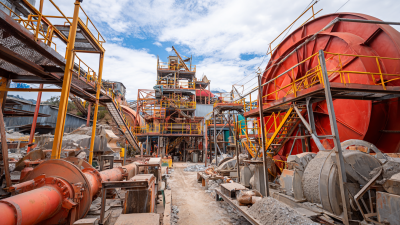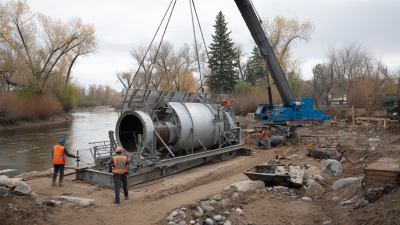

When it comes to modern filtration tech, you really can't overlook the importance of Cyclone Desanders—especially in the oil and gas world, where cutting corners isn't an option. Recent reports are buzzing about the industry growing at a pretty solid rate—like 5.8% CAGR—and expected to hit around $43 billion by 2026. These Cyclone Desanders are honestly game-changers because they do a great job at removing sand and other pesky particles from drilling fluids, which means better filtration and overall efficiency.
 Shanghai Shangjiang Petroleum Engineering Equipment Co., Ltd. has been leading the way with some pretty innovative cyclone separation products. They've been constantly tweaking and upgrading their designs and materials to keep up with what the industry needs. Thanks to these improvements, the equipment lasts longer and performs better, helping the industry move toward more sustainable practices. It’s pretty impressive how much these little devices make a difference, right?
Shanghai Shangjiang Petroleum Engineering Equipment Co., Ltd. has been leading the way with some pretty innovative cyclone separation products. They've been constantly tweaking and upgrading their designs and materials to keep up with what the industry needs. Thanks to these improvements, the equipment lasts longer and performs better, helping the industry move toward more sustainable practices. It’s pretty impressive how much these little devices make a difference, right?
Cyclone desanders might not be the most glamorous part of industrial processing, but honestly, they’re pretty vital when it comes to making filtration more effective. Basically, they use centrifugal force—think of it like spinning really fast—to toss out solid particles from liquids. The cool thing? They’re built to handle huge amounts of material, which makes them perfect for industries like oil and gas, mining, or water treatment. And here’s the kicker: keeping sediment out helps prevent clogging and keeps everything running smoothly, so you don’t end up with equipment issues or downtime because of buildup.

Plus, cyclone desanders aren’t just about efficiency—they’re kinda eco-friendly too. They help cut down waste and make better use of resources because you don’t have to clean or maintain your filters as often. That means your equipment lasts longer and your operational costs can go down. On top of that, they improve the quality of the final product, making sure you meet standards and keep your customers happy. As industries keep looking for smarter ways to work, it’s clear that cyclone desanders are a pretty important piece of the puzzle in modern filtration tech.
Cyclone desanders might sound like tech jargon, but honestly, they’re pretty amazing when it comes to modern filtration, especially in water treatment and industrial processes. I mean, these devices are quite efficient — they can remove up to 95% of particles between 20 and 50 microns, which is a huge improvement over the old-school filters we used to rely on. How do they do it? Well, it’s all about that cyclonic swirl inside, which spins the fluid really fast and uses centrifugal force to push the heavier solids outward to the walls, so only cleaner water gets through.
And here's a bonus: they don’t need much fussing over. Maintenance is minimal, which makes them super cost-effective in the long run. In most cases, they can run for months without needing someone to come in and tinker with them. Plus, they’re pretty flexible — they can handle different flow rates, making them great for everything from city water plants to industrial wastewater setups. Basically, adding cyclone desanders to your filtration systems means better water quality and smarter resource use. They’re a small but mighty step toward more sustainable solutions.
| Metric | Value | Unit |
|---|---|---|
| Average Removal Efficiency | 95 | % |
| Typical Flow Rate | 50 | m³/h |
| Operating Pressure Drop | 0.5 | bar |
| Maintenance Frequency | 6 | months |
| Expected Lifespan | 10 | years |
| Energy Consumption | 2.5 | kWh/m³ |
| Installation Cost | 15000 | USD |
| Return on Investment (ROI) | 3.5 | years |
Cyclone desanders really pack a punch compared to your traditional filtration setups, especially when you’re dealing with big batches of contaminated fluids. You know how regular filters use screens or membranes that can get clogged up after a while? Yeah, they need a lot of maintenance and replacing. But with cyclone desanders, it's a different story. They use centrifugal force to kick those solids out more effectively, so your system doesn’t have to stop as often, and you end up spending less on running costs. Plus, if you're working with abrasive stuff, these things are gold—they cause less wear and tear on your equipment.
And here’s the thing, they actually perform better when the particle sizes and densities aren’t consistent. Traditional filters can really struggle with mixed-up materials, leading to uneven results. Cyclone desanders, however, are pretty good at adapting to changes in the feed, which means you get steady flow and better separation every time. That not only improves the quality of the filtered liquid but also helps your system last longer. All in all, cyclone desanders are becoming a go-to choice for many industries because they’re reliable, efficient, and handle the evolving demands pretty well. They’re definitely a solid tool for modern liquid-solid separation — simple but effective, you know?
So, when it comes to water treatment, using cyclone desanders can actually bring quite a few advantages — they’re pretty much a game-changer. Basically, these devices do a great job at removing sediment and tiny particles from the water, which means the whole process becomes way more efficient. Because of that, treatment plants don’t have to spend as much time and money fixing or replacing filters, which adds up over time. Plus, they can handle more water at once, so they can serve more people without needing to pump tons of extra cash into new equipment.
On top of that, installing cyclone desanders isn’t just good for saving money — it actually helps make water treatment more eco-friendly. They improve water clarity, so the plant doesn’t need to rely as much on chemicals like coagulants, saving more cash and reducing chemical use. Plus, water with fewer impurities puts less stress on the pumps and other gear, which means those parts last longer overall. When treatment facilities start using cyclone desanders, they’re not just cutting costs — they’re also stepping up their game in being more sustainable. All in all, it’s a win for everyone — the community, the environment, and the bottom line too.
You know, with the way climate change is turning up the heat—literally and figuratively—on cyclones, it’s becoming clearer than ever just how important cyclone desanders are in today’s filtration tech. Especially for industries dealing with the chaos that comes with super strong storms—like what Auckland experienced after Cyclone Gabrielle—they’re realizing more and more that having reliable separation equipment is a total game-changer. There are plenty of success stories from different sectors showing how cyclone desanders really help get rid of debris and sediment, which means cleaner water and less downtime for operations. It’s pretty impressive stuff.
If you’re thinking about investing in these systems, it’s good idea to think about your specific environment—like what kind of contaminants you’re dealing with and what conditions are typical for your location. Also, keeping these systems well-maintained and upgrading them when needed can make a big difference in how long they last and how well they work. Don’t forget, partnering up with tech developers can bring in some fresh innovations—solutions tailored just for your unique challenges.
Take the oil and gas industry, for example—there’s been a lot of focus on improving cyclone separation tech. It’s proven essential, especially when trying to bounce back quickly after cyclone damage. By implementing these advanced systems, companies can better protect their resources and stay productive, even when climate storms threaten to throw everything off course.

: Cyclone desanders primarily enhance filtration efficiency by using centrifugal force to separate solid particles from liquids effectively.
Cyclone desanders are commonly used in industries such as oil and gas, mining, and water treatment due to their capability to handle large volumes of materials.
They contribute to sustainability by reducing waste, optimizing resource use, and minimizing the need for frequent cleaning and maintenance of filtration systems.
Cyclone desanders can achieve a separation efficiency of up to 95% for particle sizes ranging from 20 to 50 microns.
Cyclone desanders require minimal maintenance and can operate continuously for several months in typical conditions without manual intervention.
The enhanced filtration efficiency of cyclone desanders leads to better quality products that meet regulatory standards and enhance customer satisfaction.
Cyclone desanders can handle varying flow rates and are versatile enough to be used in settings like municipal water treatment facilities and industrial wastewater management.
Their minimal maintenance requirements and long operational intervals contribute to their cost-effectiveness in long-term applications.
By effectively removing solid particles, cyclone desanders help maintain the integrity of downstream equipment and prevent interruptions caused by sediment buildup.
Cyclone desanders utilize cyclonic motion to generate centrifugal forces that allow for the efficient separation of heavier solids from liquids.
Cyclone desanders are pretty essential these days when it comes to modern filtration tech, especially if you're looking to boost efficiency in industrial setups. Basically, they work by using centrifugal force to separate out solids from liquids — and honestly, they do a much better job than traditional filters. You know, they tend to last longer and cost less to maintain, which is a big plus for any operation.
From an economic standpoint, installing cyclone desanders can really save you money in the long run. They help make water treatment more cost-effective and make better use of resources overall. Lots of examples from different industries show how effective these devices are — keeping flow clean and protecting equipment down the line. Here at Shanghai Shangjiang Petroleum Engineering Equipment Co., Ltd., we’re super committed to pushing the envelope with advanced cyclone separation tech, all aimed at improving how we separate and filter stuff for the oil and gas industry.






